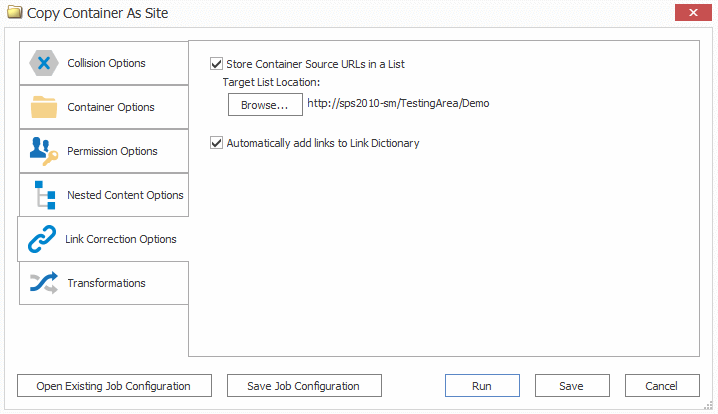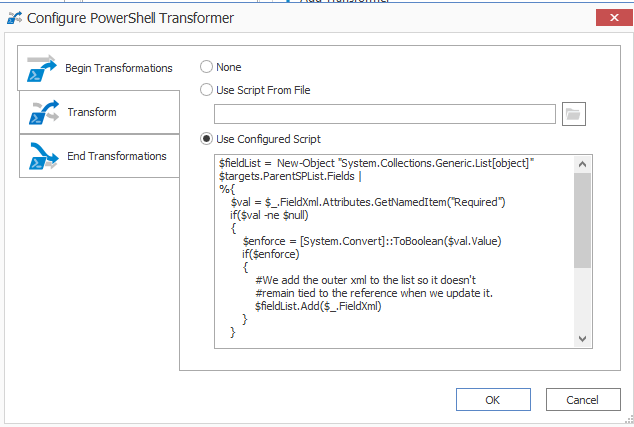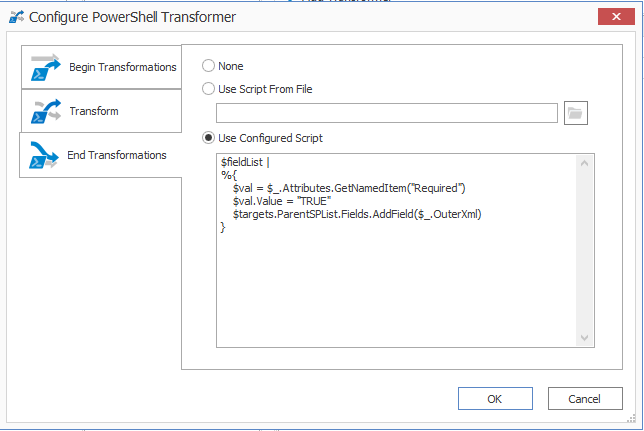Link Correction Options
Metalogix Content Matrix can correct eRoom Link objects that are migrated as items in a SharePoint Links list. If these links point to an internal location they will be corrected to the new target location as part of a migration. Metalogix Content Matrix can also correct links in column data within document libraries and lists.
When content is migrated from eRoom to SharePoint, Metalogix Content Matrix will create a SharePoint list called MigrationSourceURLs, with a column called MigrationSourceURL, and will place the URL for that eRoom container into this field. The MigrationSourceURLs list will store the source URL data for the eRoom containers that are migrated, and the MigrationSourceURL column will hold the actual URL value. A TargetURL column will also be added to the list, for the migration target URL. This way, users can see the source and target URLs for the eRoom links.
NOTE: While Link Correction Options are configured before the migration, both the mapping of links and the actual running of the link correction are done as post-migration actions.
To configure Link Correction Options:
To configure Link Correction Options:
1.To have URLs from the source eRoom container/content saved into a SharePoint list, Make sure the Store Container Source URLs in a List box is checked.
2.For Target List Location, click [Browse] to open a SharePoint tree view window, and select the site under which you want the list to be created.
A MigrationSourceURL column will be created in this list and will list the source eRoom URL, and another column will list the target SharePoint URL to which the eRoom container was migrated.
NOTE: If the same location is used for multiple migration additional entries will be added to the existing list, without overwriting any previous entries (unless the same source container has been migrated to multiple locations).
3.If you want the source URL to be automatically added to the links to Link Dictionary for the post-migration link correction, make sure the Automatically add links to Link Directory box is checked.
Transformations Options
You can view, create, and edit Transformers which, as the name implies, "transform" content during migration.
There are several built-in, non-editable transformers that Metalogix Content Matrix uses to process data during the migration. Advanced users can also create custom transformers using PowerShell.
The Transformations tab consists of two main sections: Available Definitions and Applied Transformers For <Object>. The Available Definitions section will list all of the transformation definitions that are available for the current migration action, in alphabetical order. For example, the Site definition is available when migrating at the site level or higher. However, if migrating as a document library or migrating documents, this definition will not be listed.
When one of the Available Definitions items is selected, any transformations that exist/have been configured within the migrating content will appear. Some of the actions that may be grayed out. These grayed out items are mandatory transformations that are run during the course of a normal migration, and these actions cannot be edited or removed. However, they can be reordered by using the up and down arrows to the right-hand side of the window if you want a transformation action to occur before a mandatory action. Actions that appear and are not grayed are user added transformations, and can be moved, edited and deleted at the users discretion.
In some cases, you could add another instance of an existing transformer, and then have it run in two different locations within the migration process. One could be run in the middle, and it could be run again just before the end.
Using PowerShell to Create Custom Transformations
When you select the Add Transformer > Invoke PowerShell script option for an Available Definition, you can use custom PowerShell scripts to create your own transformations beyond the built-in capabilities of the Metalogix Content Matrix.
Specify when you want the script to run by selecting one of the following options:
Begin Transformation The transformation script will run before the migration of the affected objects, allowing you to read and make changes to objects on the source before objects themselves migrate.
Transform The transformation script will run while the migration of the affected object(s) is in progress. For example, the user mapping between source and target would be run using the Transform option.
End Transformation The transformation script will run after the migration of affected object(s), allowing you to read and make changes to objects on the target.
EXAMPLE: The following Transformer consists of two scripts for disabling and re-enabling the Required setting for a column list.
·The first script entered into the Begin Transformation tab sets the setting of any columns that are Required to false before copying begins.
·The second script, entered into the End Transformations tab, sets the setting back to true after item migration has completed.
Saving or Running a Migration Action
When you finish configuring a migration action, you can run it immediately or save a copy of the settings to a job file, which displays in the Job List section. You can then:
·run a migration directly from the Job List section
OR
·create a PowerShell script and schedule it to run as a Windows Scheduled Task
OR
·trigger jobs in the Content Matrix Console to run using PowerShell.
You can also save the job configuration as a template so that you can preserve and reuse settings for future migration jobs.
When the migration starts, a status dialog box will appear. The job logs can be viewed (in progress or after the migration is finished) by clicking [Details>>]. The Status section of the status box will list a live count for the number of successes, warnings, failures, etc. for the migration. The Progress section of this dialog will list any completions and the type of completion (Sites, lists, items, users, groups, etc.). A Migration Completed message will appear when finished. Click Close to exit the status dialog.
IMPORTANT: As of version 9.2, Distributed Migration has been removed from Content Matrix eRoomEdition, and you will no longer have the option to Run Remotely.



